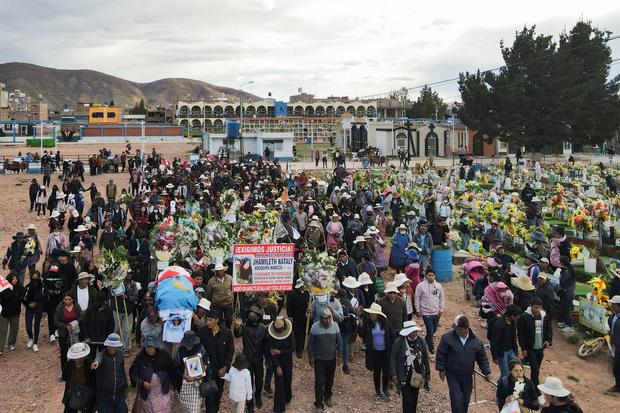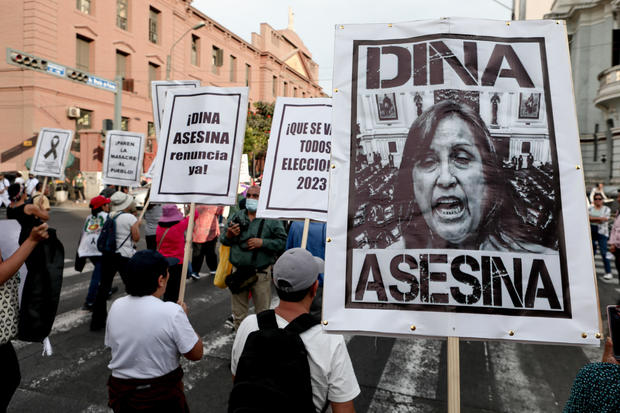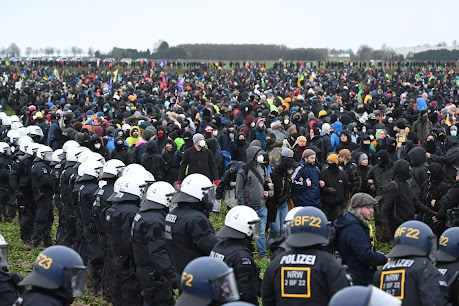Jan 15, 2023
Peru Declares State of Emergency in Lima Over Protests
Agence France-Presse

LIMA —
Peru's government late Saturday declared a state of emergency in the capital Lima and three other regions due to protests against President Dina Boluarte that have claimed at least 42 lives in recent weeks.
The measure, in force for 30 days, authorizes the army to intervene to maintain order and suspends several constitutional rights such as freedom of movement and assembly, according to a decree published in the official gazette.
Supporters of ousted president Pedro Castillo have marched and barricaded streets across the South American country since December, demanding new elections and the removal of Boluarte.
On Friday night, she refused to step down, saying in a televised address: "My commitment is with Peru."
The state of emergency covers Lima, the regions of Cusco and Puno, as well as the port of Callao, adjacent to the capital.
More than 100 protest roadblocks were in place across Peru on Saturday, mainly in the south, which has been the epicenter of the unrest, and also around Lima.
The airport in Cusco, gateway to the famed Machu Picchu site in southern Peru, reopened Saturday after being shuttered over a flare-up in the protests.
Authorities on Thursday suspended operations as a preventative measure at the airport, which handles the second most air traffic in the country, after demonstrators tried to reach the transportation hub.
In December, it suspended operations for five days.
The mass anti-government demonstrations first broke out in early December, after Castillo was ousted from office for attempting to dissolve Congress and rule by decree, seeking to prevent an impeachment vote against him.
Peru has faced political instability in recent years, with 60-year-old Boluarte being the sixth person to hold the presidency in five years.
Castillo, who was being investigated in several fraud cases during his tenure, has been remanded in custody for 18 months, charged with rebellion.
16 January 2023

Riot police stand guard at the Plaza de Armas in Cusco, Peru on January 15, 2023, as residents carry out a rally for peace in memory of the 42 people that died in recent protests. (AFP)
- At least 42 people have died in five weeks of clashes as protesters demanded fresh elections and Boluarte's resignation
- The unrest has been largely concentrated in the southern Andes, where Quechua and Aymara communities live
LIMA: Peru's capital Lima and three other regions were under a renewed state of emergency Sunday, with deadly weeks-long protests against President Dina Boluarte showing no signs of abating.
At least 42 people have died, according to Peru's human rights ombudsman, in five weeks of clashes at burning roadblocks and other flashpoints to demand fresh elections and Boluarte's resignation.
She took over on December 7 as the South American country's first woman president following the impeachment and arrest of leftist Pedro Castillo for his failed bid to dissolve Congress and rule by decree.
Castillo, a former rural school teacher and union leader, faced vehement opposition from Congress during his 18 months in office and is the subject of numerous criminal investigations into allegations of widespread graft.
His ouster sparked immediate nationwide protests, mainly among the rural poor, that petered out over the holiday period but resumed on January 4.
The government extended by 30 days a state of emergency from midnight Saturday for the regions of Lima, Cusco, Callao and Puno, authorizing the military to back up police actions to restore public order.
The state of emergency also suspended constitutional rights such as freedom of movement and assembly, according to a decree published in the official gazette.
In Puno, epicenter of the protests, the government declared a new night-time curfew for 10 days, from 8:00 pm to 4:00 am.
Almost 100 stretches of road remained blockaded Sunday in 10 of Peru's 25 regions -- a record according to a senior land transport official.
Baluarte intransigent
Some 500 Peruvians, including several dozen police officers, attended a mass Sunday in Lima's central cathedral for fallen protesters, as well as for a policeman burnt alive in the city of Juliaca on the border with Bolivia.
Many of the mourners wore white T-shirts to symbolize peace and bore photographs of the dead.
Lima Archbishop Carlos Castillo, who led the service in Spanish and the Quechua Indigenous language, called for peace and an end to the "spiral of violence."
"The blood that is spilled does not cry out for vengeance," he said.
"May the terrible cruelties that were done to some," including to "our burnt policeman brother, may these cruelties disappear from our horizon."
On Friday, Boluarte expressed her "regret" for the deaths, but insisted: "I will not resign."
An Ipsos poll published Sunday said Boluarte had a 71-percent disapproval rating.
More than 100 Peruvian, Argentine and Chilean intellectuals, meanwhile, urged Boluarte in an open letter published late Saturday to "stop the massacre of citizens who exercise their legitimate right" to protest.
"We ask Dina Boluarte to listen to the demand of the people and to resign, to immediately abandon the position and call immediate elections," it added.
The unrest has been largely concentrated in the southern Andes, where Quechua and Aymara communities live.
The Inter-American Commission on Human Rights has said that in order to end the crisis, these groups need to be better integrated into Peruvian society.
Jose Muro, deputy minister of territorial governance, told TV Peru Sunday the government would create "spaces for dialogue" countrywide to discuss unanswered social demands.
Mass demonstrations have meanwhile been announced for Monday in Lima as well as the marginalized southern Andean regions.
Dozens of demonstrators arrived in the capital's Miraflores district on Saturday night as part of a mobilization for a "takeover of the city."
The airport in Cusco, gateway to the famed Machu Picchu site, reopened Saturday after being shuttered two days earlier, the second time it had been closed due to the protests.
Train services to the historic Inca citadel resumed on Sunday.
Unions say the tourism industry was losing up to seven million sols (1.7 million dollars) a day.
Unstable regime
Peru has been politically unstable for years, with 60-year-old Boluarte the country's sixth president in five years.
Castillo has been remanded in custody for 18 months, charged with rebellion and other crimes.
The authorities insist radical groups are behind the protests, including remnants of the Shining Path communist guerrilla group.
As proof, they have presented the capture this week of a former member of that organization, Rocio Leandro, whom the police accuse of having financed some of the unrest.
Peru mourns people killed in protests amid state of emergency
Issued on: 15/01/2023 -
Lima (AFP) – Peru's capital Lima and three other regions were under a state of emergency Sunday, with deadly weeks-long protests against President Dina Boluarte showing no signs of abating.
At least 42 people have died, according to Peru's human rights ombudsman, in five weeks of clashes at burning roadblocks to demand fresh elections and Boluarte's resignation.
She took over on December 7 as the South American country's first woman president following the impeachment and arrest of Pedro Castillo for a failed bid to dissolve Congress and rule by decree.
Castillo, a leftist former rural school teacher and union leader, faced vehement opposition from Congress during his 18 months in office and is the subject of numerous criminal investigations into allegations of widespread graft.
His ouster sparked immediate nationwide protests, mainly among the rural poor, that petered out over the holiday period but resumed on January 4.
The government extended by 30 days a state of emergency from midnight Saturday for the regions of Lima, Cusco, Callao and Puno, authorizing the military to back up police actions to restore public order.
The state of emergency also suspends constitutional rights such as freedom of movement and assembly, according to a decree published in the official gazette.
More than 100 stretches of road remained blockaded Sunday in 11 of Peru's 25 regions -- a record according to a senior land transport official.
Mass
Dozens of people attended a mass Sunday in Lima's central cathedral for the fallen among the protesters as well as a policeman burnt alive in the city of Juliaca on the border with Bolivia.
Many of the mourners wore white T-shirts to symbolize peace, and bore photographs of the dead.
Lima Archbishop Carlos Castillo led the service in Spanish and the Quechua Indigenous language.
The unrest has been largely concentrated in the southern Andes, where Quechua and Aymara communities live.
The Inter-American Commission on Human Rights has said that in order to end the crisis, these groups need to be better integrated into Peruvian society.
Jose Muro, deputy minister of territorial governance, told TV Peru Sunday the government would create "spaces for dialogue" countrywide to discuss unanswered social demands.
"Tell our brothers that this week we intend to establish spaces for dialogue to begin meeting the demands," he said.
Mass demonstrations have meanwhile been announced for Monday in Lima as well as the marginalized southern Andean regions.
On Saturday night, dozens of demonstrators arrived in the capital's Miraflores district as part of a mobilization for a "takeover of the city".
The airport in Cusco, gateway to the famed Machu Picchu site, reopened Saturday after being shuttered two days earlier, the second time it had been closed due to the protests.
Train services to the Inca citadel resumed on Sunday.
Unions say the tourism industry was losing up to seven million sols (1.7 million dollars) a day.
Radical groups?
Peru has been politically unstable for years, with 60-year-old Boluarte the country's sixth president in five years.
Castillo has been remanded in custody for 18 months, charged with rebellion among other crimes.
The authorities insist radical groups are behind the protests, including remnants of the Shining Path communist guerrilla group.
As proof, they have presented the capture this week of a former member of that organization, Rocio Leandro, known within the group as "Comrade Cusi."
According to police spokesman General Oscar Arriola, Leandro financed the unrest that left a dozen dead in the Ayacucho region.
He called Leandro "a Marxist, Leninist, Maoist assassin."
© 2023 AFP
Peru's deadly protests prompt officials to close Cusco's popular tourist hub airport and trains
JANUARY 13, 2023
Lima — Weeks-long protests that have killed dozens across Peru continued on Thursday, with escalating tensions in the Andean city Cusco prompting the government to preemptively close the tourist hub's airport. Supporters of ousted president Pedro Castillo have marched and barricaded streets around the South American country demanding new elections and the removal of current leader Dina Boluarte.
The demonstrations have at times turned violent and almost 50 people have been killed in clashes with security forces, including a police officer who was burned alive in a vehicle, while hundreds more have been injured. Different officials have given different death tolls this week, but most Peruvian outlets were saying at least 47 people had died amid the unrest.
Almost half of the victims died in clashes Monday night in the southern Puno region, where 17 people were buried Thursday.

Major flashpoints have occurred near Peru's airports, which are guarded by security forces after protesters stormed runways during an initial wave of uprisings in early December.
In Cusco, the gateway city to Peru's tourism crown jewel Machu Picchu, the main airport was closed suddenly Thursday "as a preventative measure," Peru's transportation ministry announced on Twitter.
The train connection between Cusco and the historical site has been suspended until further notice, the railway company said in a statement, citing safety concerns.
Clashes broke out Wednesday night in Cusco, the former capital of the Inca empire, with protesters attempting to enter the airport, while some torched a bus station, attacked shops and blocked train tracks with large rocks. Peru's rights ombudsman said one person died and more than 50 people, including 19 police officers, were injured in the turmoil, while police said they had arrested 11 people.
Seventeen dead protesters were laid to rest Thursday in Juliaca, a city in the southern Puno region close to the Bolivian border.

Gathered in a circle around a red coffin, relatives of one of the victims held posters reading: "Dina corrupt murderer" and "we are not terrorists but citizens who demand justice."
"It is painful to lose a member of your family for fighting for your rights," 48-year-old Fidel Huancollo, whose cousin had died, told AFP.
A 16-year-old protester, hospitalized since Monday, died Thursday in Juliaca, bringing the total number of civilians killed there to 18.
Also on Thursday, trade unions, left-wing parties and social collectives marched through Lima, the capital that has largely been spared violence so far, to denounce a "racist and classist... dictatorship."

In addition to demanding Boluarte's resignation, protesters want Congress to be dissolved and a new body set up to rewrite the constitution — which was adopted in 1993 under the mandate of Alberto Fujimori. That former president is serving a 25-year prison sentence for crimes against humanity committed during his time in power.
The mass demonstrations broke out in early December after Castillo was ousted from office for attempting to dissolve Congress and rule by decree, seeking to prevent an impeachment vote against him.
Roadblocks remain in 10 of Peru's 25 departments, the transport superintendency said.
Boluarte, 60, was Castillo's vice president but took over once he was ousted on December 7.
Castillo, who was being investigated in several fraud cases during his tenure, has been remanded in custody for 18 months, charged with rebellion.




.jpg)







